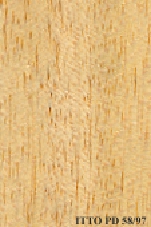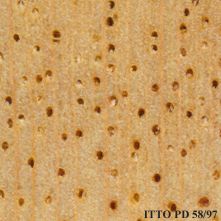
CEIBA, FROMAGER (Ceiba pentandra)
Trade Name
Ceiba, Fromager
Scientific Name
Ceiba pentandra (L.) Gaertn.
Family
BOMBACACEAE
Common Names
Samaúma Lisa (Brazil); Samaúma (Brazil); Cotton Wood (United Kingdom); Ceiba (United States of America); Panya (Trinidad & Tobago); Panya (Jamaica); Panya (Nicaragua); Paineira (Brazil); Ceiba (Peru); Huimba (Peru); Guambush (Ecuador); Uchuputu (Ecuador); Mapajo (Bolivia); Lupuna blanca (Peru); Kalngebárd; Ceiba (Venezuela); Kapok; Kalngebard; Kaddo Bakkoe; Fuma; Doum; Cyyba; Cutin; Cottontree; Cottin; Ceibo;Xiloxochitl; White cotton-tree; Sumaumeira; Sumauma commum; Silk-cotton-tree; Silk-cotton; Seiba; Poxot; Pochotle; Pochotl; Pochote; Piton; Piim; Peem; Ogouma; Ofua; M`fuma; Konde; Kapokier; Grand bois; Fromagier; Enyenoa; Egungun; Cotonnier; Corkwood; Ceibon; Cabellos de angel; Busana; Busan; Bousana; Bouday; Bossongo; Bois coton; Betenbi; Benten; Bentegnie; Bentang; Baumwollenbaum; Baumwollbaum; Banan; Bana; Arbre a coton; Arbol de algodon; Odouma (Gabon); Bouma (Gabon); Doukm (Gabon); Odouma (Cameroon); Bouma (Cameroon); Silk cotton-tree (United States of America); Ceiba (United Kingdom); Ceiba (Germany); Kakantrie (Netherlands); Fromager (France); Fuma (Congo); Fuma (Zaire); Doum (Cameroon); Okha (Nigeria); Araba (Nigeria); Ghe (Liberia); Onyina (Ghana); Fromager (Côte d`Ivoire); Enia (Côte d`Ivoire); Banda (Sierra Leone); Ngwe (Sierra Leone) Ceiba De Garzón; Bulik; Bongo; Bonga (Colombia); Batte Ni Gan` Ken; Atgodon Di Manila; Araba; Algodon De Manila; Sumahuma; Kumaka; Ceiba (Colombia); Cabello De Angel; Cabello De Algodón; Árbol De Algodón (Mexico); Pachote; Fromager (Guyana); Ceibón (Nicaragua); Ceibo Jabillo; Ceiba Yuca (Venezuela); Ceiba De Lana; Kapok Tree; Cork Wood; White Cotton Tree; Silk-Cotton Tree; Cotton Tree; Ceiba (Bolivia)
Scientific Name Synonyms
Eriodendron anfractuosum DC.; Ceiba thonningii A. Chev.; Bombax pentandrum L.; Bombax occidentale Spreng.; Bombax guineense Thonn. in Schumann; Ceiba guineensis (Thonn.) A. Chev.; Ceiba casearia Medik.; Ceiba caribaea (DC.) A. Chev.; Ceiba anfractuosa (DC.) Maza; Bombax pentandrum L.; Bombax occidentale Spreng; Bombax guineense Thonn. in Schumann
Description Of The Tree
Botanical Description
The trees are reported to be some of the largest in the Amazonia, reaching heights of up to 60 m, with trunk diameters of 200 cm or more. The boles are cylindrical over the well developed buttresses, covered with spines, with commercial lengths of about
Natural Habitat
Ceiba pentandra is a pioneer, fast growing, species found in the humid areas of varzea primary forests and in secondary forests. In Bolivia it is reported in transitional savanna and rain forests at altitudes of about 250 m. In Africa Ceiba pentandra is found more or less scattered in secondary forest formations.
Natural Distribution
It is reported in tropical America, West Africa, Southeast Asia and throughout the West Indies.
Plantations Available?
This species is planted in tropical areas throughout the world.
Non Timber Uses
The seeds are crushed and used in soups in Africa, they are reported to contain 20 to 25% of an edible oil which is also used as a lubricant and for soap manufacture.
Wood Identification
Anatomic Description Of Wood
Occasionally wood semi-ring porous and/or ring porous. Tangential diameter of vessel lumina 200 micras or more (large). Colored deposits in heartwood vessels. Tyloses common. Vessels per mm2 less than 6 (rare). Axial parenchyma absent or extremely rare, non visible with magnifying glass (8x). Apotracheal axial parenchyma diffuse and/or diffuse in aggregates. Paratracheal axial parenchyma scanty and/or vasicentric. Axial parenchyma in continuous tangential lines (in Prismatic crystals in the ray cells. Heterogeneous rays and/or multiseriate heterogeneous rays.
-
 Wood Macro Photo Tangential Plane
Wood Macro Photo Tangential Plane
-
 Wood Micro Photo Of Transversal Section
Wood Micro Photo Of Transversal Section
Availability
Cites Status
Unrestricted
General Wood Description
Color
The sapwood is pale white. The heartwood is described as reddish or pale -yellow.
COLOR INDEX (1=Black, 7=Light yellow,white)
6
Grain
It has highly interlocked grain; special care is needed when drying because of frequent risks of distortion.
Texture
Texture is medium to coarse.
Luster
Luster is medium to rather low.
Natural Durability
This species is considered as non durable to decay or insect attacks.
Natural durability index (1= Very high durability, 7=Vey low durability)
5
Internal Growth Stresses
No growth stresses are reported in this species.
Silica Content
Negligible contents of silica are found in timber of this species. Amounts over 0.05% may affect the wood processing. Silica Value: 0.01
Resistance To Impregnation
Easy to treat with a full penetration of the preservative products using vacuum-pressure method.
Wood Physical Properties
Basic Density or Specific Gravity (O.D. weight/vol. green) (g/cm³)
0.31
Air-dry Density (Weight and volume at 12%MC) (g/cm³)
0.33
Total shrinkage Tangential (Saturated to 0%MC) (%)
5.2
Total shrinkage Radial (Saturated to 0%MC) (%)
2.5
Drying Defects
Ease of Drying: The timber seasons well with little degrade.
Recommended Dry Kiln Schedule
US-T10-D5S; UK-J; JUNAC-A; FR-4
Dimensional stability ratio (Total Tangential Shrinkage %/Total Radial Shrinkage %)
2.1
Actual Dry Kiln Program
http://itto.git.grav-dev.com/wp-content/uploads/2015/08/KD_USA_ENG.pdf
http://itto.git.grav-dev.com/wp-content/uploads/2015/08/KD_British_ENG.pdf
http://itto.git.grav-dev.com/wp-content/uploads/2015/08/KD_JUNAC_SPA.pdf
http://itto.git.grav-dev.com/wp-content/uploads/2015/09/KD_French.pdf
Wood Chemical Properties
Wood Mechanical Properties
Bending Strength (MOR),12%MC (kgf/cm²)
339
Stiffness (MOE) 12%MC (kgf/cm²)
41797
Compression parallel to fiber 12%MC (kgf/cm²)
198
Compression perpendicular to fiber 12%MC (kgf/cm²)
21
Shear strength radial 12%MC (kgf/cm²)
37
Janka hardness (side) 12%MC (kgf)
125
Janka hardness (end grain) 12%MC (kgf)
192
Workability
Sawing
This wood is difficult to saw cleanly, because it is very soft and tends to tear out or leave fuzzy edges.
Rotary Veneer Cutting
This species is used for peeling, it does not require a thermal treatment.
Sliced Veneer
This species is used for peeling, it does not require a thermal treatment.
Blunting Effect
The wood exerts a slight blunting effect on cutters.
Machining
This species is easy to machine.
Planing
Cutting edges must be kept very sharp since worked surfaces tend to be woolly. Reduced attack angles are recommended.
Moulding
The wood is rated as fairly difficult to mould. Fuzzy surfaces are reported to be common.
Turning
30
Boring
The wood is extremely soft. It tends to tear out and leave woolly surfaces in boring operations.
Nailing
Nailing is easy, but nail-holding properties are very poor.
Gluing
The wood is reported to glue well.
Sanding
Particular care is needed to avoid woolly aspect of the surface.
Polishing
Needs pre-coating.
Response To Hand Tools
The material is reported to be easy to work. Torn grain is common.
REFERENCED USES
End Uses Summary
HOUSING GENERAL, panelling, fittings, FURNITURE AND CABINETS, common furniture, cabinets, PLYWOOD AND VENEER, faces, cores, common veneer, TURNING, SPORTS, table tennis, PACKING, light packing, NAVAL CONSTRUCTION, boats, OTHER AND MUSICAL INSTRUMENTS, handicrafts, door core, scale model
General Housing
- 10 - Silica in Timbers
Paneling
- 18 - W3TROPICOS Missouri Botanical Garden
Fittings
- 19 - Silica in Timbers
Furniture Cabinets
- 21 - Tropical timbers of the world. Part III-Southeast Asian and Oceanian Species.
Furniture, Common
- 23 - Handbook of Hardwoods
Cabinet
- 24 - Empire Timbers
Panels, Veneers
- 25 - Directory of Timber Trade Malaysia
Faces
- 26 - Annual Review and Assessment of the World Timber Situation 1998-ITTO
Cores
- 27 - Embassy of Brazil in Japan
Common Veneer
- 29 - Embassy of Ecuador in Japan
Turning
- 30 - Embassy of Honduras in Japan
Sports
- 38 - Annual Review and Assessment of the World Timber Situation 1998-ITTO
- 41 - Embassy of the Philippines
Packing
- 45 - Recopilación y Análisis de Estudios Tecnológicos de Maderas Peruanas
Light Packing
- 46 - ECUADOR, Inventario y Aprovechamiento de los Bosques del Sur Ecuatoriano
Shipbuilding
- 55 - Tropical Timber Atlas of Latin America
Boats
- 56 - Manual de Identificación de Especies Forestales de la Subregión Andina.
Handcraft
- 66 - Maderas latinoamericanas. VII. Caracteristicas anatomicas. propiedades fisicomecanicas, de secado, y tratabilidad de la madera juvenil de Cordia alliodora (Ruiz & Pav. Oken.)
Door Cores
- 76 - Descripción General y Anatómica de 105 Maderas del Grupo Andino.
Scale Models
- 83 - Algunas caracteristicas fisicomecanicas de la madera de tres especies de la cordillera NeoVolcanica
Please Provide Information To View Producer Information